|
An Altogether Too Wordy Note
About Tweaking the Kit and Techniques for the AT10RC
6/26/2011. I installed my oft-threatened anti-gravity device for assisting the focuser. I am pretty sure that even RCOS Ritcheys ($12-15k, used, for this discontinued aperture) never came standard with a bungee cord attached to the focuser. Why ever not?
6/29/2011. Maybe the bloated stars late in an overnight imaging session owe less to focus shift as the 'scope cools than I imagined. Maybe dew is involved. I found moisture on the prinary while putting things away one morning last week; presumably there was more on the secondary. It finally occured to me that I could and should do something about that. You can buy a flexible dew shield with cut-outs for the top and bottom D-rails of the AT10RC, or you can take an AstroZap shield for every other 10-inch telescope and go to work with a carpet knife and shears. My choice (of course):

Here's a collection of incremental tweaks and tweaks-in-progress:
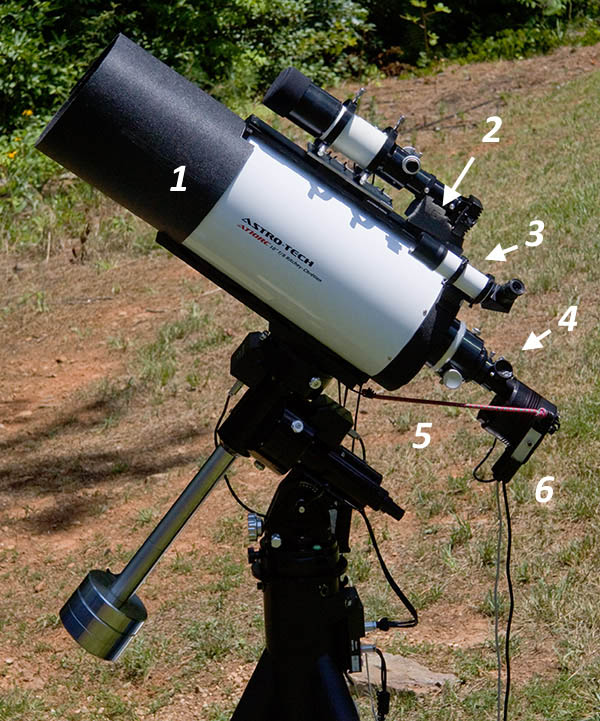
- AstroZap dew shield, notched for rails.
- Foam support under guide-scope focuser.
- A-P finder mount and 50mm finder with interchangeable eyepieces.
- Off-axis guider (a work in progress; taped over for now).
- Bungee cord to take weight off focuser when lifting imaging package.
- Aluminum tube protecting fragile electrical connections on ST2000XM.
Unmarked: I could use another counterweight. An 18- and a 10-pounder are shown mounted a couple of inches beyond maximum extension of the optional heavy-duty counterweight bar and its extender. I removed the toe-saver to get a little more room. Or, if I develop a ton of confidence in the off-axis guider, I'll simply remove the ST80 guide 'scope and its mounting hardware.
The phrase of the day is "let's see." About item 1: we'll have to see how it behaves; hanging all that plastic off the nose will have an effect on the tail-heaviness of the AT10RC, good or bad. You take a 10-inch block of quartz and build a telescope around it; the rock dominates the cg calculations. Item 3: the holes in the rear end cap do not line up for both mounting holes in the A-P finder base, but a single bolt seems to hold a 50mm finder pretty solidly. I suppose it would be easy to drill and tap a new hole, but I don't want to make holes I don't need, so let's see how this works before making drilling noises. Item 5: I bet there are a dozen better ways to arrange a bungee, but before looking for them, let's see if this is at all helpful for achieving perfect focus.
I have clear weather all over the 5-day forecast. Let's see if that means anything.
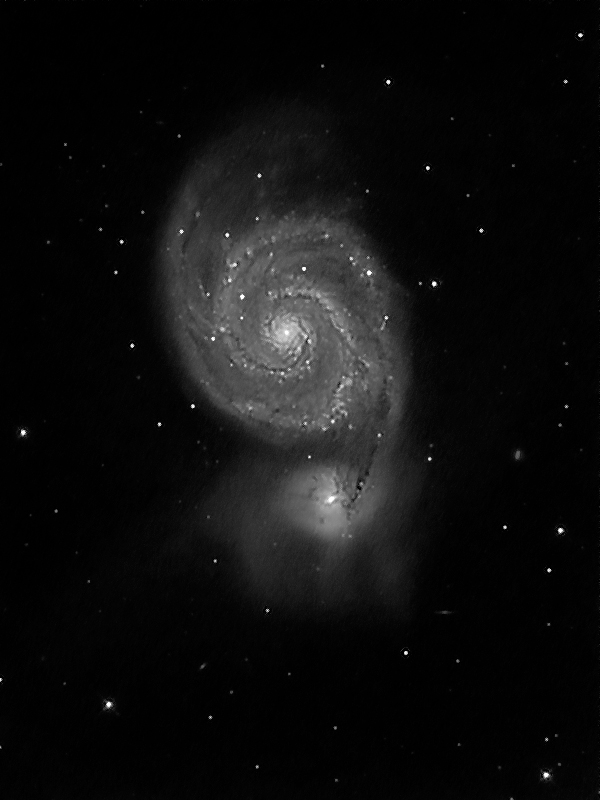

Last night, I took darks and flats while blowing hot air out of the tube. Over the course of about an hour, I watched star images improve from about 4.5 to 2 arc seconds. This is what comes from setting a telescope out in 90 degree weather and then trying to use it as twilight falls. The first image showed clear signs of field rotation (I'm finally starting to recognize this) so a careful tweak of polar alignment was in order and helped tremendously. I kept my subs to 300s because I was sure they would be sharp(ish) and in white light that seems to be enough to get reasonable deep-sky images. Achieved PSF's in the finished photos are still up around 3.0 - 3.4 seconds, perhaps owing to over-aggressive guiding.
Here are two frames. The M51 image was exposed 24x300s in L at 2x2 (2 hours). Abell 2151, the Hercules galaxy cluster, was exposed 31x300s in L at 1x1 (2h 35m, the remainder of the night). Trying A2151, at almost half a billion light-years, was a reality check to see if these distant clusters are worth pursuing with my current setup. Yes! Tonight I plan to shoot some color for A2151 and then collect L all night long.
6/30/2011. I went outside to set up the telescope for overnight imaging. Its 12v power supply was dead. Apparently overheated. But the high was only 86oF today, and it's rated to 104oF. Then I realized that it was in a clear plastic box for rain protection. Ah, I thought: greenhouse effect. So I called the county elections office and registered as a Republican. Now it works.
No, I didn't. But I did cover the outside of the box with highly reflective aluminum A/C duct tape. The power supply cooled off almost immediately when I brought it inside for testing, and I suspect that the new, heat-shielded box will solve most or all my thermal problems. Some kind of shade might be needed, too.
The sky seems very still but not especially transparent tonight. In the twilight, I ran the exhaust fans on the rear cell of the Ritchey and watched a 9th magnitude star near Arcturus (above and left in the photo below) as it tightened up from a long smear with a PSF over 5 arc seconds across to a nice, clean 1.4 arc second star. The slightly hazy sky and good seeing suggest I should spend time on something bright and detailed tonight. First, while waiting to see if the sky would improve or close down, I went looking for ghosts. That is, while still aimed at the 4th brightest star in the sky, I collected 300s of LRGB data, then stretched the photo as if I were processing a deepsky image. I wanted to know if this optical train produces reflections or other artifacts that I should allow for. It seems very clean:
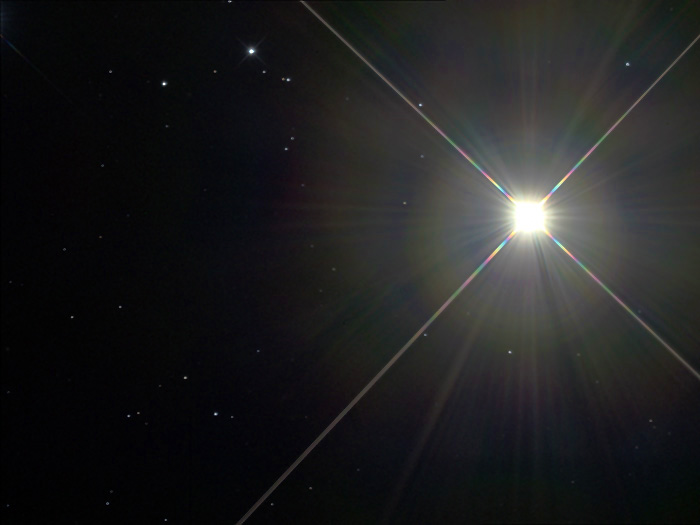
Arcturus
300s LRGB
Having decided that this is not a night to collect pre-cambrian photons from A2151, I took aim at M51. This time I ran the camera at full resolution (1x1 non-binning) and took several five minute gulps. Here's 16 of them combined with 1 frame each in R, G, and B:
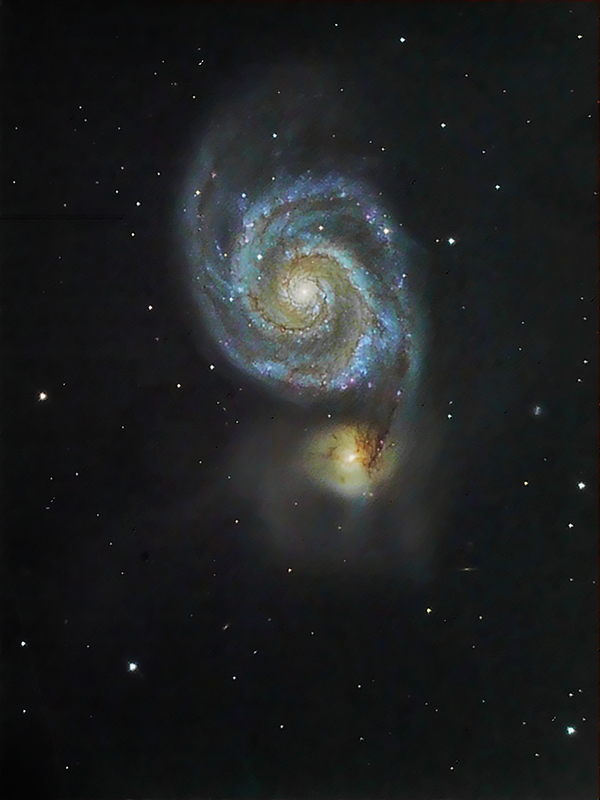
M51, with Supernova
16x300s L, 300s RGB
I think the focusing aid helps, as does the extra support under the guider, as does better polar alignment, as does using the exhaust fans, as does the dew and glare shield, as does the steadier air. Like I said some days back: make enough incremental improvements and eventually you'll see the difference. Next up: get the OAG working to try to tighten up the stars some more while using longer subframes. Also, tonight's flat is not as good as it needs to be for this degree of dynamic range stretching (see the large dark donut hole left of the secondary galaxy?). And I've probably been too aggressive with the sharpening algorithms --there's plenty of time to tweak all that. Things are coming along.
7/01/2011. A Baader T-thread to 1.25-inch adapter with helical focusing threads and a good 1.25-inch snout arrived in today's mail. The Baader widget really is silky smooth and provides fine focus over a 6-7mm range. Alas, far too smooth. There's just no way the guide camera will stay in any particular orientation without turning owing to any minor force. Out on the net, a spectroscopist using one of these and faced with the same problem avered that a nylon set screw added to the collar fixed it right up. OK then. I'll use steel until I can get to a store, but fine: let's tap a 10-24 hole through there and use a socket cap head machine screw. Finer would be better, but this is what I've got.
I drilled as clean a hole as I could and tapped it. Not clean enough! Tiny metal shards got all through the helix. I've spent an hour cleaning them out with a jeweler's loupe and a dental pick, and I've finally got the full range of travel again (started with about 10%). I think the too-free-rotation problem has been solved, but not as I intended: who needs the set screw when the threads are as hard to turn as these are now? Still, if I can twist it to a precise focus and leave it... that's what I wanted all along though my inner machinist be mortified.
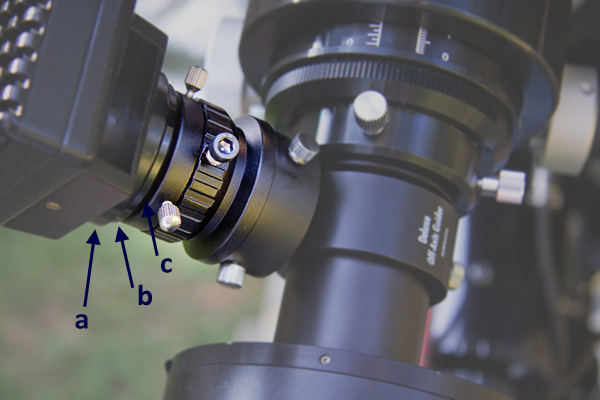
Baader t-thread to 1.25" helical focuser,
the midrange model, not the ClickLock version,
with big ole 10-24 socket cap screw added to
lock / allow focusing motion. Letters refer to
tomorrow's impromptu whittling session.
Mortification diminishing: I kept working the threads and blowing out shrapnel as a kind of pastime, like Captain Queeg's ball bearings or any number of peoples' prayer beads, until smooth motion was restored. Now the set screw is required, and it works as intended. The Baader adapter is mounted on the OAG with the guide camera installed. Once I see the guide camera come to focus and see it guide on something, I'll spend time looking for the proper nylon set screw.
Under the stars.... oh, so close! I need to remove just a few mm of extension to get the guide camera close enough to focus. I could try fiddling with the spacing of the imaging CCD (maybe), but I'd rather not mess with what I know is a solid connection there. Tomorrow I'll work on the mounting hardware on the front of the DSI Pro. There are kits available to get rid of it completely in lieu of a T-mount faceplate, but that's overkill. If I screw up, I can always go that route. Rather than waste another good still, semi-transparent night, I've put the DSI back behind the guidescope and will put it to use doing something that will benefit from high-resolution.
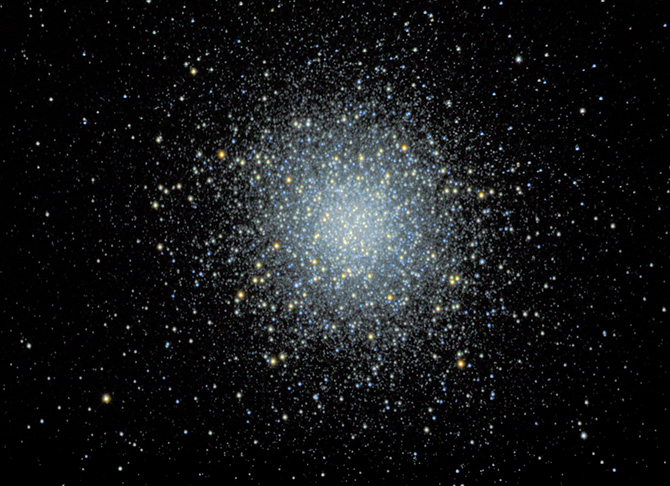
M13, a globular cluster in Hercules
L 150s x 105, RGB 300s x 1
4h22m in L, 5m each in RGB
Maxim DL's photometric tools and selected bright stars from Guide 8 say this image
reaches substantially deeper than magnitude 20. Isolated stars measure 21.5 - 22. The Sun at this distance would
be a 19th magnitude star.
The core of M13 burns out in 300 seconds, so I used half that exposure. The shorter exposures also serve to minimize trailing from whatever cause so star images are that much tighter. The bottom half (E or W) of the luminance channel in this image has round star images on the order of 1.8 - 2.1 arcseconds. In the top third they are 3.3 - 3.7 (I corrected them in FocusMagic as if they were motion blurred before posting the image). The larger PSF's are streaked rather than merely bloated, so I'm not entirely sure what's going on. Guiding was on the yellow star outside the cluster at 5 o'clock (2 second exposures). I should recheck collimation before messing with shims.
A consideration for future efforts: it occurs to me that the OAG, unlike the guidescope, must guide on stars away from the center of the frame (duh!). That means that field rotation from poor polar alignment will always be a liability when OAG'ing. Learn to align the Mach1 using Uncle Rollo's methods.
7/02/2011. I put myself to sleep thinking up jigs to hold the DSI mounting hardware for a pass on the chop saw to remove some of the height of the filter-slide holder. But this morning I decided to use an orbital sander with an 80-grit disk to shorten the threaded ring on the front of the filter holder instead. Think of the sander as a casual milling machine for soft metal. It only took a couple of minutes to reduce the total length of the mounting hardware on the DSI from 0.85 to 0.78 inches (a reduction of 1.8 mm). Then I reinstalled the older 1.25-inch snout. While it is too small in diameter for a set-screw to hold it securely, the brass band in the Baader adapter holds it well. The advantage of this snout is that it has no shoulder at the base of the t-threads: it threads entirely inside the mounting flange of the DSI. That means that the flange itself became the limiting factor for inward travel of the guide camera, which is why I sanded that rim down as far as I did, until it is flush with the base of the old 1.25-inch snout. So, by un-exchanging the snout and spending a few minutes sanding the aluminum bracketry, I've removed the thickness of the shoulder at the base on the new snout (b), the length of the unthreaded portion of t-thread side (c), and 0.07 inches of the shoulder itself (a). The DSI's guide chip can be set ~4-5 mm closer to the OAG pickoff prism which ought to be plenty for it to come to focus. It's back on the OAG waiting for dark.
Next: I soldered a 12v DC plug on the wire to the jack that powers the Ritchey's fans so I don't have to rely on a fistful of AA's to blow air out of the tube. That could be important since it takes an hour or so to clear out tube currents. My intent was to let the fans blow longer. The AA's had a few hours on them when I made the swap and had evidently weakened: now the fans move air better, too. This is another mod waiting for dark.
It's 93F outside, and the Sun is shining on the box holding the power supply. It works fine so far (the shields are holding, cap'n).
Clouds all afternoon and evening promised a night off. But after cleaning up the kitchen and welcoming Amy back from her twilight walk (I sat this one out), I stepped outside and saw that the sky had partly cleared. So what now? I really don't want to discover that things aren't working when I'm not ready to spend all night fixing them. I really don't want to go back several squares and start rethinking them, either. I'd rather not chase sucker holes hour after hour, and I certainly don't want uncertain results from marginal skies sending me off on false trails. But why, exactly, did I do all this if not to try it out? It's not as if it takes hours (as it once did), to set up shop and give it a go. So I uncovered the 'scope, turned on the fans, and plugged up the computer. Of course.
Within ten minutes, I had focused guide stars on the guide chip via the off-axis guider. I slewed to M51 and found a couple of guide candidates with surprising ease by rotating the OAG body. I calibrated on one of them and set about shooting while the camera and telescope cooled down. I have not refocused, re-aligned on the pole, or anything else. This is not about pretty images tonight; it's a plausibility check for the off-axis guider setup (and yet, see below). With three and four second guide integrations, the outfit seems to be working as it should.
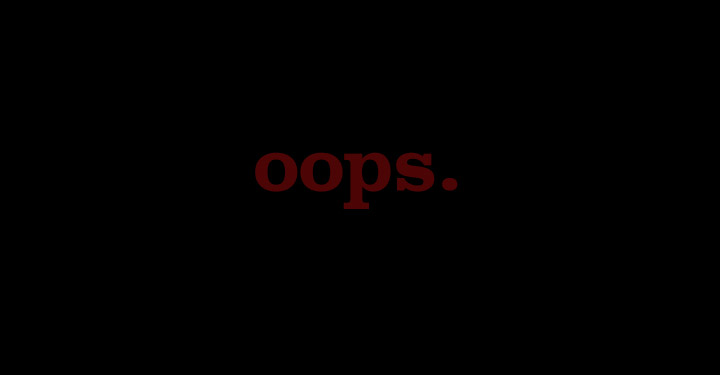 At the start, PSFs from tube currents were ugly and huge. The photo shows a star from the first 300s integration and the same star in a later image, both at full scale; the FWHM size of the bloated star is 4.9 seconds; in the the seventh image it is 1.9 seconds. The FWHM doesn't really tell the tale this time: the dimmer 50% of the first image spreads out across a lot more than 4.9 seconds. Tube currents were greatly reduced in half an hour or less. (RCOS notes that its high end R-C's take 1 -2 hours to cool with their fans running; I'm sure mine cools no faster. So start the fans early.) I'm taking 300s images for direct comparison with previous frames, though I am tempted to try longer. Just wait and watch for a while and then decide what to nudge. And be happy: this works. At the start, PSFs from tube currents were ugly and huge. The photo shows a star from the first 300s integration and the same star in a later image, both at full scale; the FWHM size of the bloated star is 4.9 seconds; in the the seventh image it is 1.9 seconds. The FWHM doesn't really tell the tale this time: the dimmer 50% of the first image spreads out across a lot more than 4.9 seconds. Tube currents were greatly reduced in half an hour or less. (RCOS notes that its high end R-C's take 1 -2 hours to cool with their fans running; I'm sure mine cools no faster. So start the fans early.) I'm taking 300s images for direct comparison with previous frames, though I am tempted to try longer. Just wait and watch for a while and then decide what to nudge. And be happy: this works.
Actually, this works very well! Look at this awful-looking tracking graph:

PHD Guide tracking record
Meade DSI in Off-Axis Guider behind a 10" F8 Ritchey-Chretien,
vertical scale is about 1.2 arc seconds, interval varies between
2 and 4 seconds as hazy skies demand
The "stars" you see in this screen shot are actually hot pixels. Guide stars are fewer and far softer. I need to tweak the focus of the guide camera, but there is a lot of room on either side of its present setting, so no worries there. The vertical scale of the tracking corrections is about 1.2 arc seconds, so the guiding only looks awful, especially where clouds hide the guide star and the guider goes off chasing phantoms. Putting numbers to the graph: the RMS is under one second of arc (which is on the order of 1/60 of an inch at 100 yards). So despite the sierran appearance of the tracking profile, it should not be a surprise that achieved PSFs on my individual 300s frames are the best yet. Stars are round and about 2.2" across, wall to wall. It's not a clear night and it's not an especially steady one, either.
The first two frames were wasted owing to tube currents (I've left the fans running, so the PSFs might be even better if I turned them off). I'm going to take ten more images, then darks and flats, then call it an early night and savor these successes.
Clouds slid in and completely shut down the sky about halfway through the final exposure. Even so, it looked OK. I've excluded it from the following stack which includes the nine best frames (i.e., not the last one and neither of the first two images made while watching the OTA cool down) and uses the 15 minutes of color data from last night:
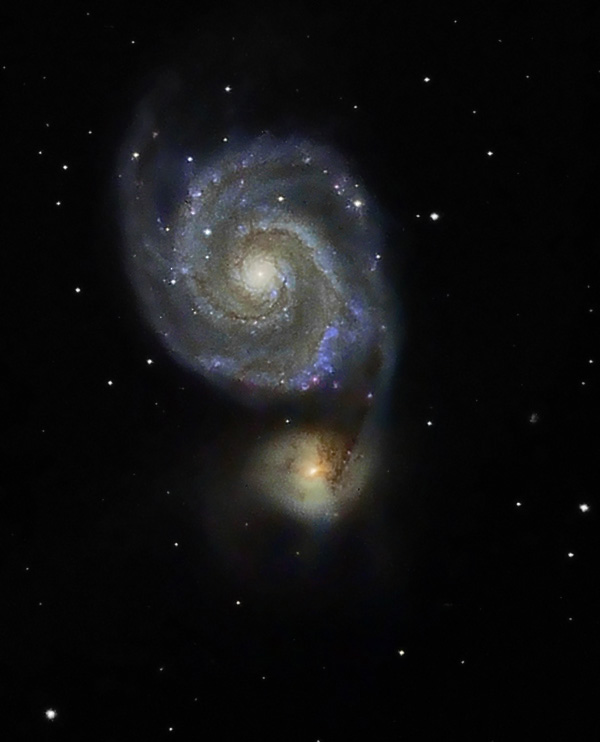
M51
9x300s L, 1x300s RGB
L images guided via OAG
Tonight's luminance frames are noisy because they are thin and vastly stretched owing to the poor transparency. Star images in the final luminance stack are between 1.9 and 2.6 arc seconds FWHM. And let me say one last time: this was not a clear night by any sane standard. But it was clear enough to suggest that the next order of business is not fixing this or that but making good pictures. Finally!
7/4/2011. No, wait. One more thing. My favorite cross-hair eyepiece would not come to focus in the finder, so I lopped an inch out of the finder's tube and turned an external bushing from a short section of 2-inch ID aluminum tubing to reconnect the front and rear pieces. Focuses just fine now. How does anyone get along in this sport without a lathe and assorted soft metal stock?
 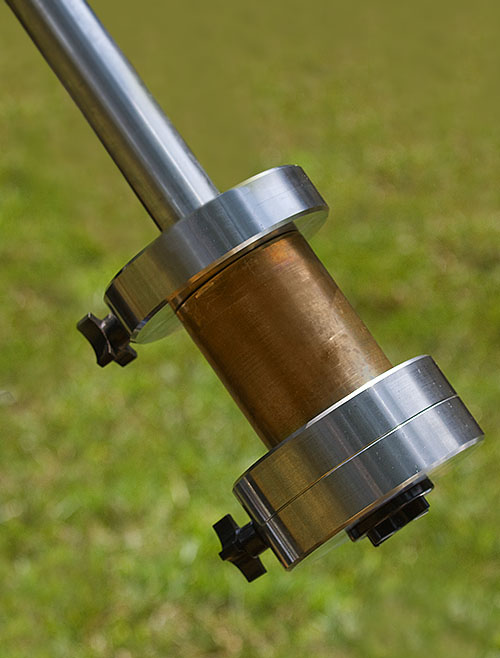
And another one: I keep going on about needing another counterweight, but I don't really want to spend the money and wait on weight. So I faced a piece of bronze tubing (every telescope needs some brass, afterall, and bronze is close enough) and inserted it between the two steel counterweights. The wall is about half an inch thick, and the tube adds 5.5 pounds to the counterweight stack. It moves the 10-pounder several inches up the counterweight arm, and since the point is reinstalling the toe-saver, doing so costs another inch or so. It's a net gain, but is it enough? It is. Seems just right.
The inner surface of the bronze weight is about half an inch outside the 1.875-inch diameter counterweight arm. I wasted a lot of time thinking about wooden spacers, trimming fender washers, making lead rings, or, or, or... before it (finally) dawned on me that it doesn't really matter if the bronze weight is perfectly concentric with the counterweight arm. All that really matters is that it not be allowed to shift suddenly during an exposure. You know what I finally thought of? Orphaned socks. They do have a use. You can snip the toe out of one and stretch it around the tube, tucking the open ends inside. The sock then protects the steel from the ends of the bronze weight (as if the steel needs protection). Then stuff a second orphaned sock inside the tube to take up the extra space. Sandwich the bronze between steel weights as shown and you're done. Since making the photo, I've polished the bronze with Brasso until it gleams (because that's just what one does, not that you could see it inside its stretched, orphaned stocking). I suppose I could drill and tap a set screw and rig up a couple of internal spacers for positioning and for additional weiight. And I might. Some other cloudy day.
7/06/2011. That was so successful, I decided to do it to excess using a bigger piece of brass tube / pipe / oil-field detritus lurking in the scrap-pile downstairs. This one was too big for my lathe, but it was reasonably well faced to begin with.
The new weight didn't polish up as nicely as the previous one did, and it's too heavy to count on rags and socks to keep it in place. I drilled and tapped a 1/4x20 hole for a lock screw and then fit two 0.875-inch brass rods inside to take up some of the missing interior space and allow it to ride roughly concentric with the counterweight arm. It's about 11 inches long, weighs 21#, and takes the place of yesterday's 5.5# counterweight. The entire counterweight package can move several inches up the shaft, meaning there is room for different payloads (200mm F2.0 Nikkor feeding a Canon 20D, anyone?). I need a brass cap nut to protect the counterweight shaft; except for that, this looks entirely satisfactory. I still couldn't find a balance point without the shaft extender, so it remains.
The Mach1GTO now carries the counterweight shaft extension which weighs 6#, a 10# weight, the new 21# brass weight, and an 18# weight, for a total of 55 pounds. By unclamping the RA clutch until the axis turns freely, I feel no imbalance at all, so I m sure that whatever small imbalance must remain is well within the abilities of the RA motor. (Physics puzzle of the day: have I reduced the angular momentum that must be overcome in the course of RA guiding by increasing mass and reducing the moment arm? Or is it a wash, or have I made things worse? What will this do to settling time when focusing or guiding? I am out of practice at such things. There may be too many variables to judge by squinting at the problem. Just use it.)
7/17/2011: Have not seen a star since July 2 and am getting a little testy about it. Just so you know.
7/18/2011: I can just see Vega through the murk and moonlight. I aimed at the clouded Moon and verified that a) yes, I can focus a 16mm Nagler through the scope (the view is not bad; this is the first time I've actually looked through this telescope), and b) Canon EOS bodies come to focus nicely enough, and c) a Canon EOS + wide 2-inch adapter + CCDT67 also reaches focus. See:
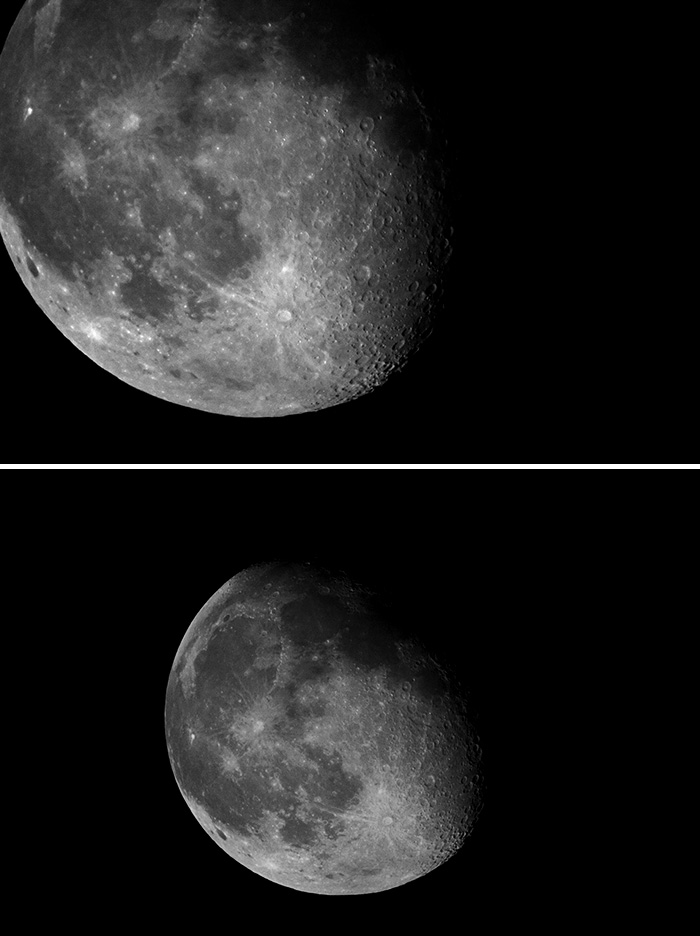
The Waning Gibbous Moon
Canon 50D, 1/400s ISO 2000
Top: native FL
Bottom: with A-P CCDT67 compressor
By measuring the distance between two prominent lunar features, I found the compression ratio using these parts to be 0.65x. Very nice! That means that the AT10RC can indeed be put to work as an F5.2 telescope using the APS-C sensor in the 50D. How flat the field, who knows, but it's nice and wide and is not obviously corrupted in the corners.
Now, how about the ST2000XM w/CFW-8a? The CCD came to focus with room to spare (though the Moon was deep in the piney canopy by the time I tried this). I measured the diameter of the Moon on the ST2000XM to be very close to 1680 pixels. Guide says the Moon tonight is 30.2 arc minutes in angular diameter. 30.2 * 60 / 1680 yields an image scale of 1.07 arc seconds per 7.2 micron pixel which corresponds to an EFL of 1430mm. Assuming the AT10RC's native FL is indeed 2000mm, then this is a compression of 0.72x. That's a little less compression than expected considering that I am using the official A-P recommended parts. Measurement may be off a bit, so wait till I get a plate solve using Pinpoint Astrometry to start worrying about adjustments. The key thing is: the Astro-Physics 0.67x CCD telecompressor works fine with an AT10RC and standard focuser. I do not think the compressor will work in conjunction with the Orion Deluxe OAG -- the OAG introduces too much space between the compressor and the sensor, so much that I would be very surprised if there were sufficient in-travel to reach focus. It's worth trying at some point, but I'm counting on using the guide telescope for F5.7 photography.
Now, I can haz starz?
|